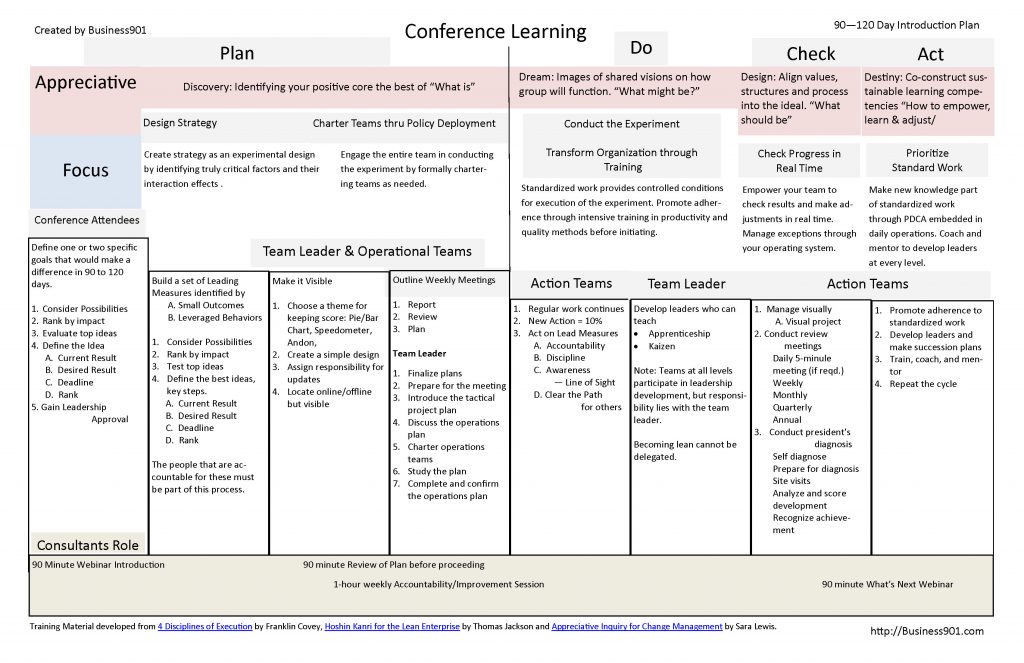I attended an outstanding conference (#LSSC12), The Lean Software & Systems Conference 2012 held in Boston, MA. In addition to the conference there was 2 days of tutorials, Lean Camp (Open Space), Interactive Cooking, Living Room, Lightning Talks, and Lean Coffee. It was an excellent agenda and well-hosted by the Lean-Kanban University. Every attendee that I had a chance to ask, echoed my assessment.
A question that permeated throughout the conference was how do I take what I learned and implement it in my organization. Most of us know that if you do not start immediately a great deal of information will be lost and eventually little if any will be implemented. My efforts this week will be to assist to make this great learning experience turn into actionable items. If we can do this, you certainly will be assured of coming back next year and I might even get another speaking opportunity.
The problem most people face when coming back from a conference is that they soon get inundated with all their regular work again. It’s not that we don’t want to introduce what we learned but there is so much to do and so little time. As part of my presentation, I discussed the aspect of Standard Work. Standard Work can be simply stated as an outline on the way you do things. It is very similar to determining a budget. A budget does not save you money it just allows you to see where the money is going. It allows you to make choices. Standard Work does the same thing. It allows you to make choices. So, the first step is to accept that we will continue to do our Standard Work but have the ability to make choices to implement something new and to allocate time and a budget if necessary to the initiative.
My preferred method of learning is utilizing an A3. If you missed Claude Perrone, the Agile Sensei talk on A3s, I have included a link to a blog post that discusses A3s, Why A3, Why Now in Lean Thinking? Utilizing an A3 will give a structured format for putting your thoughts together and outlining a course of action. Download an outline of a Problem Solving A3.
The work on the A3 should have started before you went to the conference with an outline of the purpose for going and the expectations from both a personal and an organizational perspective. If you did not do that, you can do it in retrospective.
Next determine what you learned from the conference. If you went as a group, I would encourage the entire group to be present for this step. Outline all the different thoughts and how they may apply to your organization.
Can any of these thoughts be completed simply by the stroke of a pen, something that does not require a change in culture? They may be items that are can be taken care of by a simple budget allocation, a new piece of equipment, etc. Separate these thoughts and evaluate them in your next strategic meeting or in the conference overview meeting.
Let’s get back to that cultural part, the difficult part. You have all heard the saying that “Cultural eats Strategy for Lunch.” The first thing you must realize is that you may have come back from the conference with great ideas and breakthrough thoughts. However, there is an existing culture that is going to eat all of them in one big gulp. You may even be the person that swallows the whole thing as you get tied up in all your Standard Work once again. So don’t try to change the org structure or how management thinks. Create a few wins first.
Do you have one takeaway from the conference that you are passionate about? Can you take that passion and demonstrated to the rest of the team? This should be a team exercise, try it out and see what others think.
It is best to take one initiative; one thought (not necessarily the easiest) and focus on this. Ideally, the initiative should be tied to the current strategic direction of the organization. It is your responsibility to clearly define the Why to Leadership. If you cannot, you may want to rethink and choose another initiative. The important thing is to get agreement on one single item. After doing this, set your goal with a measurement and a time. State the current state and the goal (future state) by a certain time.
In addition, you should have the power to spearhead or at a minimum be a significant participant of the implementation. Stay away from discussing the How. The how should be the responsibility of the implementers or the team. However, Leadership has the power to veto the how. If you are familiar with the Lean term, Catchball, this a good time to play.
I am going to focus my blog on the subject of “Turning your Conference Learning into Action” for the balance of the week. This is an outline of this week’s discussion.
Conference Learning PDF
Related Information:
Does Lean create Innovative Companies?
Lean Software & Systems Presentation – Business901
4 Disciplines of Execution – Lean Simplified


